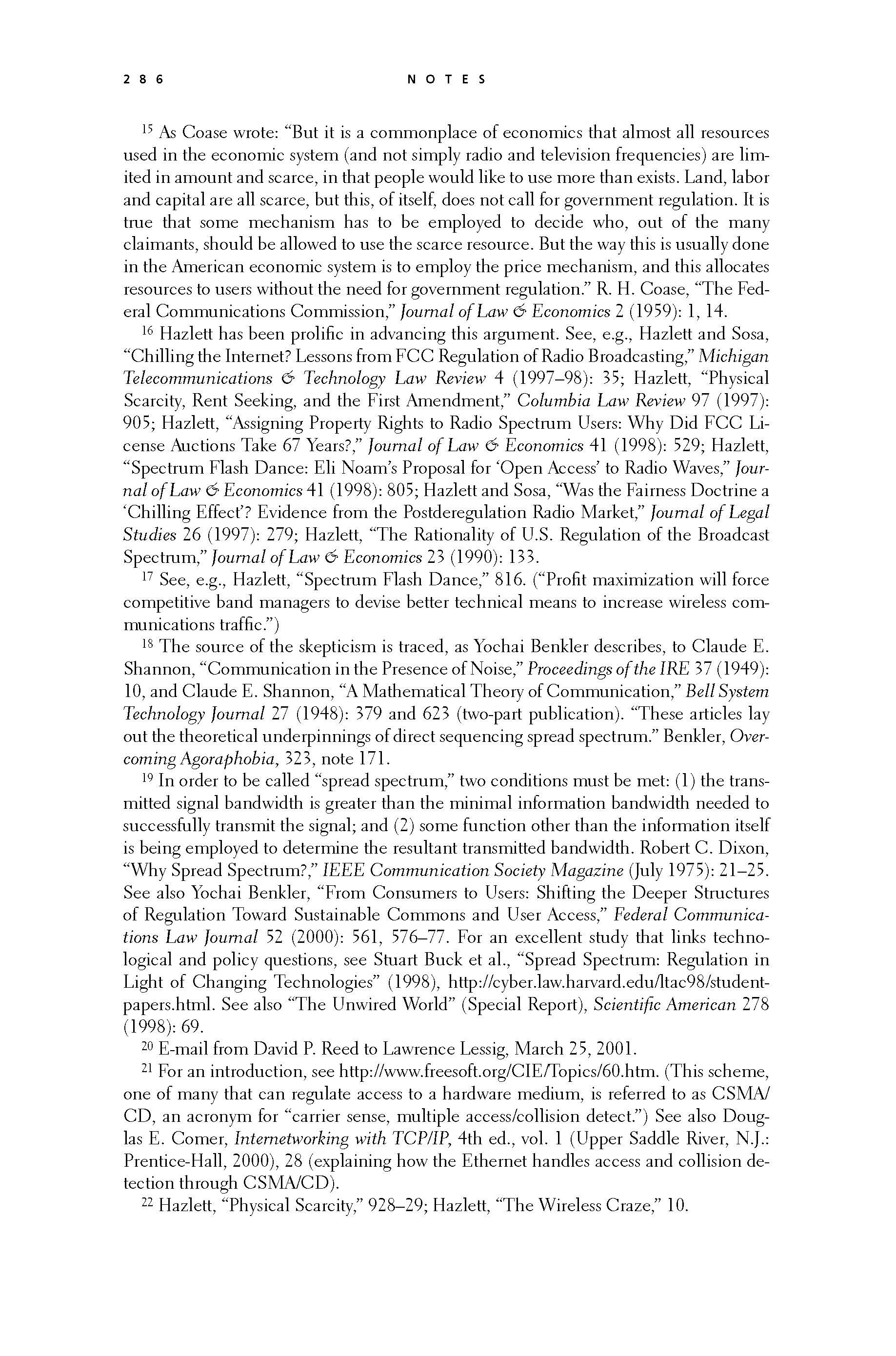 p285 _
-chap- _
toc-1 _
p286w _
toc-2 _
+chap+ _
p287
p285 _
-chap- _
toc-1 _
p286w _
toc-2 _
+chap+ _
p287
[5-15] As Coase wrote: "But it is a commonplace of economics that almost all resources
used in the economic system (and not simply radio and television frequencies) are lim-
ited in amount and scarce, in that people would like to use more than exists. Land, labor
and capital are all scarce, but this, of itself, does not call for government regulation. It is
true that some mechanism has to be employed to decide who, out of the many
claimants, should be allowed to use the scarce resource. But the way this is usually done
in the American economic system is to employ the price mechanism, and this allocates
resources to users without the need for government regulation." R. H. Coase, "The Fed-
eral Communications Commission," _Journal_of_Law_&_Economics_ 2 (1959): 1, 14.
[5-16] Hazlett has been prolific in advancing this argument. See, e.g., Hazlett and Sosa,
"Chilling the Internet? Lessons from FCC Regulation of Radio Broadcasting," _Michigan_
_Telecommunications_&_Technology_Law_Review_ 4 (1997-1998): 35; Hazlett, "Physical
Scarcity, Rent Seeking, and the First Amendment," _Columbia_Law_Review_ 97 (1997):
905; Hazlett, "Assigning Property Rights to Radio Spectrum Users: Why Did FCC Li-
cense Auctions Take 67 Years?," _Journal_of_Law_&_Economics_ 41 (1998): 529; Hazlett,
"Spectrum Flash Dance: Eli Noam's Proposal for 'Open Access' to Radio Waves," _Jour-_
_nal_of_Law_&_Economics_ 41 (1998): 805; Hazlett and Sosa, "Was the Fairness Doctrine a
'Chilling Effect'? Evidence from the Postderegulation Radio Market," _Journal_of_Legal_
_Studies_ 26 (1997): 279; Hazlett, "The Rationality of U.S. Regulation of the Broadcast
Spectrum," _Journal_of_Law_&_Economics_ 23 (1990): 133.
[5-17] See, e.g., Hazlett, "Spectrum Flash Dance," 816. ("Profit maximization will force
competitive band managers to devise better technical means to increase wireless com-
munications traffic.")
[5-18] The source of the skepticism is traced, as Yochai Benkler describes, to Claude E.
Shannon, "Communication in the Presence of Noise," _Proceedings_of_the_IRE_ 37 (1949):
10, and Claude E. Shannon, "A Mathematical Theory of Communication," _Bell_System_
_Technology_Journal_ 27 (1948): 379 and 623 (two-part publication). "These articles lay
out the theoretical underpinnings of direct sequencing spread spectrum." Benkler, _Over-_
_coming_Agoraphobia,_ 323, note 171.
[5-19] In order to be called "spread spectrum," two conditions must be met: (1) the trans-
mitted signal bandwidth is greater than the minimal information bandwidth needed to
successfully transmit the signal; and (2) some function other than the information itself
is being employed to determine the resultant transmitted bandwidth. Robert C. Dixon,
"Why Spread Spectrum?," _IEEE_Communication_Society_Magazine_ (July 1975): 21-25.
See also Yochai Benkler, "From Consumers to Users: Shifting the Deeper Structures
of Regulation Toward Sustainable Commons and User Access," _Federal_Communica-_
_tions_Law_Journal_ 52 (2000): 561, 576-577. For an excellent study that links techno-
logical and policy questions, see Stuart Buck et al., "Spread Spectrum: Regulation in
Light of Changing Technologies" (1998), http://cyber.law.harvard.edu/ltac98/student-
papers.html. See also "The Unwired World" (Special Report), _Scientific_American_ 278
(1998): 69.
[5-20] E-mail from David P. Reed to Lawrence Lessig, March 25, 2001.
[5-21] For an introduction, see http://www.freesoft.org/CIE/Topics/60.htm. (This scheme,
one of many that can regulate access to a hardware medium, is referred to as CSMA/
CD, an acronym for "carrier sense, multiple access/collision detect.") See also Doug-
las E. Comer, _Internetworking_with_TCP/IP,_ 4th ed., vol. 1 (Upper Saddle River, N.J.:
Prentice-Hall, 2000), 28 (explaining how the Ethernet handles access and collision de-
tection through CSMA/CD).
[5-22] Hazlett, "Physical Scarcity," 928-929; Hazlett, "The Wireless Craze," 10.
[[286]]
p285 _
-chap- _
toc-1 _
p286w _
toc-2 _
+chap+ _
p287